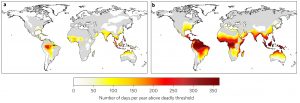UH Study Finds Deadly Heatwaves to Affect Majority of World Population

Tropical climates will feel the most severe effects of the heatwaves caused by climate change. Photo courtesy of University of Hawai‘i at Mānoa.
Seventy-four percent of the world’s population will be exposed to deadly heatwaves by 2100 if carbon gas emission continue to increase at current rates, according to a new study led by researchers at the University of Hawai‘i at Mānoa.
Published in “Nature Climate Change,” the study also found that 48 percent of humans are expected to be affected by extreme heat events, even with aggressive reductions in carbon emissions.
“We are running out of choices for the future,” said Camilo Mora, associate professor of Geography in the UH College of Social Sciences and lead author of the study. “For heatwaves, our options are now between bad or terrible. Many people around the world are already paying the ultimate price of heatwaves, and while models suggest that this is likely to continue, it could be much worse if emissions are not considerably reduced. The human body can only function within a narrow range of core body temperatures around 37 degrees Celsius. Heatwaves pose a considerable risk to human life because hot weather, aggravated with high humidity, can raise body temperature, leading to life threatening conditions.”
Little was known about how deadly heatwaves can be. To learn more, Mora led an international team of scientists and students to conduct extensive analysis of locations worldwide where temperatures have reached fatal levels since 1980. The team identified 1,900 cases of locations where heatwaves turned deadly, and found a threshold beyond which temperatures and humidities turn lethal for humans.
The threshold indicated that as relative humidity increases, lower temperatures become lethal. The study also found that the greatest risk to human life from deadly heatwaves was projected in tropical areas due to year-round heat and humidity.
“Warming at the poles has been one of the iconic climatic changes associated with the ongoing emissions of greenhouse gases,” said co-author of the study, Iain Caldwell, a UH Mānoa postdoctoral researcher. “Our study shows, however, that it is warming in the tropics that will pose the greatest risk to people from deadly heat events. With high temperatures and humidities, it takes very little warming for conditions to turn deadly in the tropics.”
“Finding a threshold beyond which climatic conditions turn deadly is scientifically important yet frightening,” said Farrah Powell, a UH Mānoa graduate student and one of the co-authors in the study. “This threshold now allows us to identify conditions that are harmful to people. And because it is based on documented cases of real people across the globe, it makes it that more credible and relevant. The scary thing is how common those deadly conditions are already.”
Recent heatwaves within the last 30 years illustrate the danger they pose to humans. In 2003, roughly 70,000 people were killed in a heatwave in Europe. In 2010, 10,000 people were killed in Moscow and in 1995, 700 people died in Chicago during lethal temperatures.
“Climate change has put humanity on a path that will become increasingly dangerous and difficult to reverse if greenhouse gas emissions are not taken much more seriously,” says Mora. “Actions like the withdrawal from the Paris agreement is a step in the wrong direction that will inevitably delay fixing a problem for which there is simply no time to waste.”














